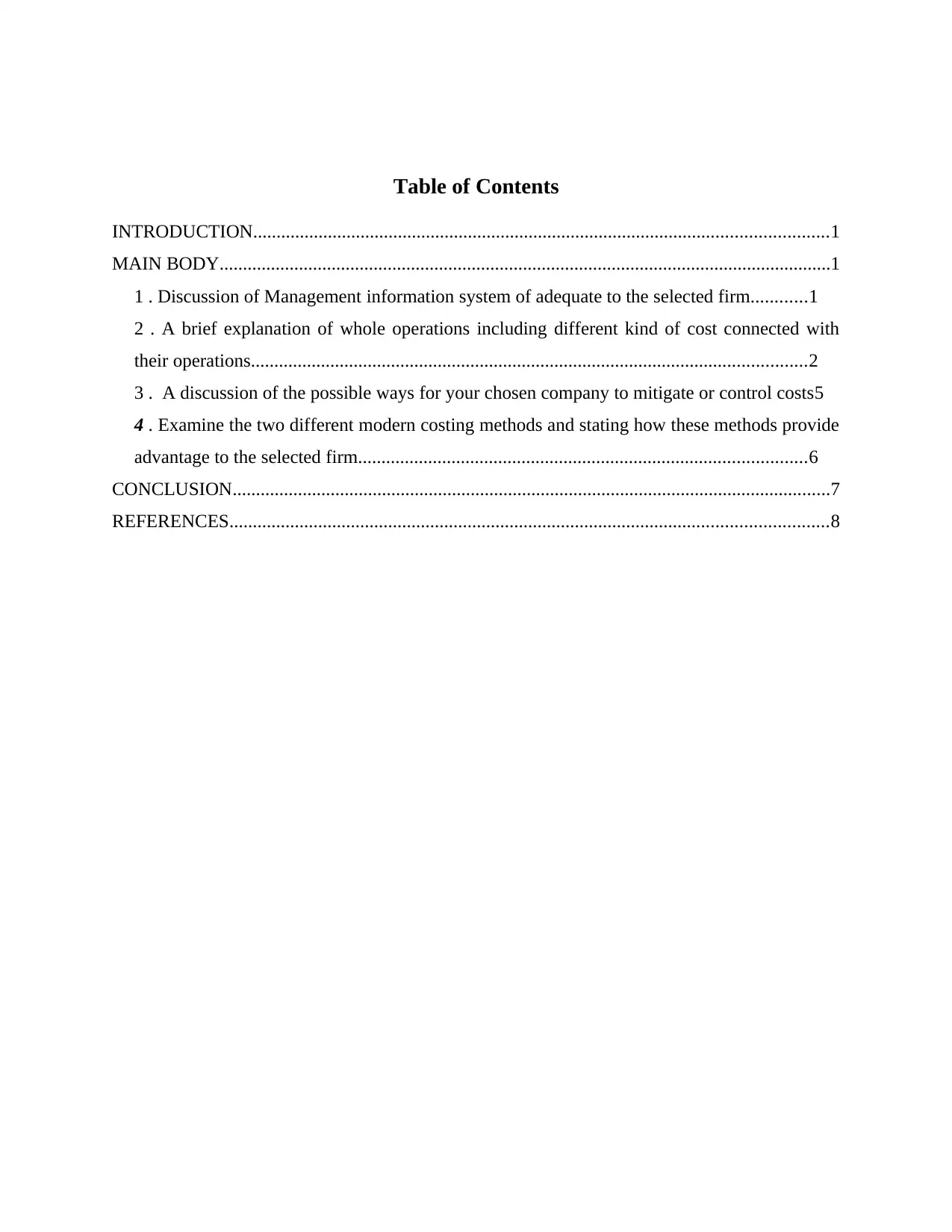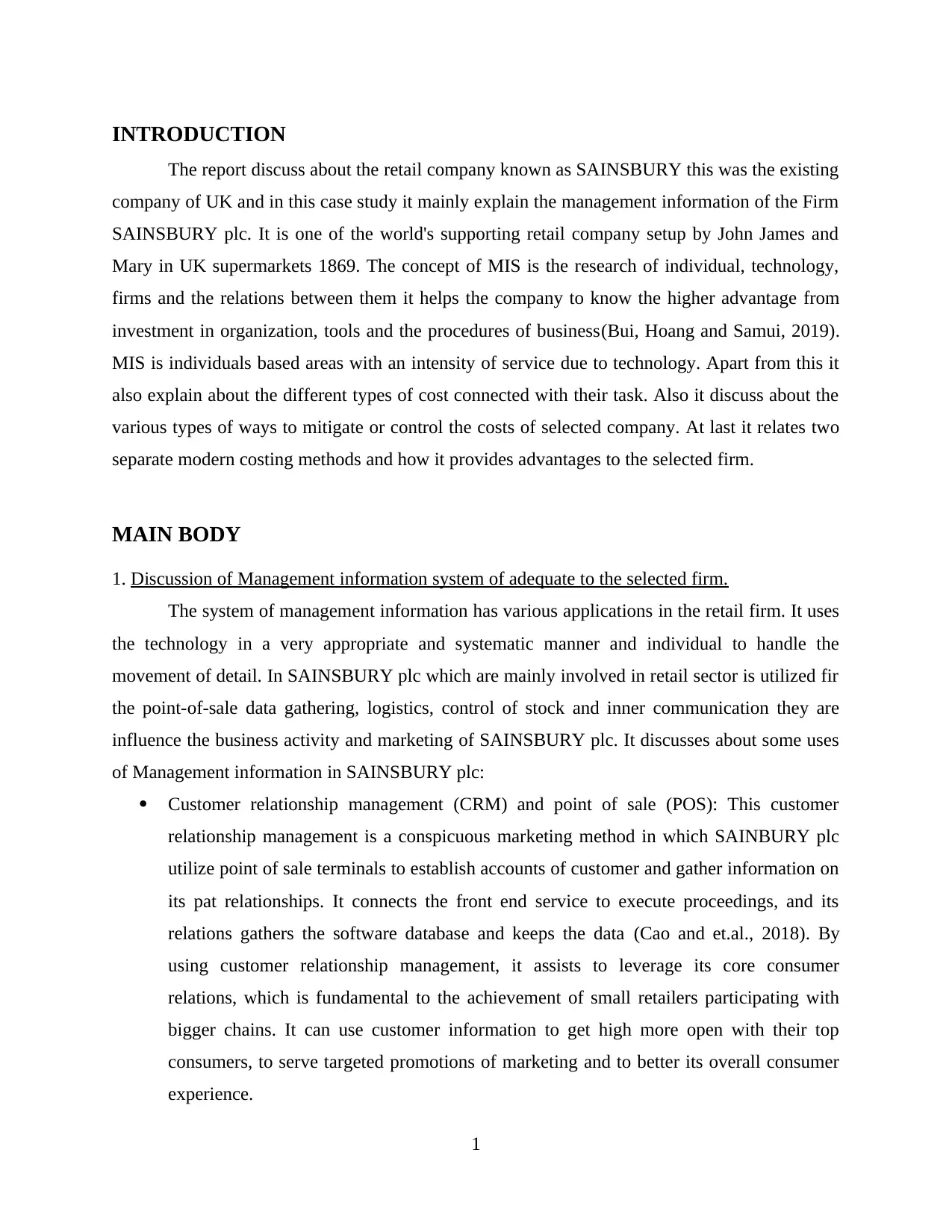Management Accounting Report: Cost Analysis and Control at Sainsbury's
VerifiedAdded on 2023/06/09
|10
|2900
|273
Report
AI Summary
This report provides a comprehensive analysis of Sainsbury's, a prominent UK retail company, from a management accounting perspective. It begins with an introduction to Management Information Systems (MIS) and their applications within the retail sector, focusing on areas such as customer relationship management, logistics, inventory control, and internal communication. The report then delves into the various types of costs associated with Sainsbury's operations, differentiating between fixed and variable costs, and exploring cost classification methods including direct and indirect costs, allocation of cost, and cost pools. Furthermore, it discusses potential strategies for cost mitigation and control within the company, such as cutting unnecessary operational costs, reducing packaging expenses, and negotiating better deals with suppliers. Finally, the report examines two modern costing methods, absorption costing, and activity-based costing, highlighting their advantages and their impact on Sainsbury's. The report aims to provide a detailed overview of financial management and cost control within the retail environment.

Introduction to
management
accounting
management
accounting
Secure Best Marks with AI Grader
Need help grading? Try our AI Grader for instant feedback on your assignments.

Table of Contents
INTRODUCTION...........................................................................................................................1
MAIN BODY...................................................................................................................................1
1 . Discussion of Management information system of adequate to the selected firm............1
2 . A brief explanation of whole operations including different kind of cost connected with
their operations.......................................................................................................................2
3 . A discussion of the possible ways for your chosen company to mitigate or control costs5
4 . Examine the two different modern costing methods and stating how these methods provide
advantage to the selected firm................................................................................................6
CONCLUSION................................................................................................................................7
REFERENCES................................................................................................................................8
INTRODUCTION...........................................................................................................................1
MAIN BODY...................................................................................................................................1
1 . Discussion of Management information system of adequate to the selected firm............1
2 . A brief explanation of whole operations including different kind of cost connected with
their operations.......................................................................................................................2
3 . A discussion of the possible ways for your chosen company to mitigate or control costs5
4 . Examine the two different modern costing methods and stating how these methods provide
advantage to the selected firm................................................................................................6
CONCLUSION................................................................................................................................7
REFERENCES................................................................................................................................8

INTRODUCTION
The report discuss about the retail company known as SAINSBURY this was the existing
company of UK and in this case study it mainly explain the management information of the Firm
SAINSBURY plc. It is one of the world's supporting retail company setup by John James and
Mary in UK supermarkets 1869. The concept of MIS is the research of individual, technology,
firms and the relations between them it helps the company to know the higher advantage from
investment in organization, tools and the procedures of business(Bui, Hoang and Samui, 2019).
MIS is individuals based areas with an intensity of service due to technology. Apart from this it
also explain about the different types of cost connected with their task. Also it discuss about the
various types of ways to mitigate or control the costs of selected company. At last it relates two
separate modern costing methods and how it provides advantages to the selected firm.
MAIN BODY
1. Discussion of Management information system of adequate to the selected firm.
The system of management information has various applications in the retail firm. It uses
the technology in a very appropriate and systematic manner and individual to handle the
movement of detail. In SAINSBURY plc which are mainly involved in retail sector is utilized fir
the point-of-sale data gathering, logistics, control of stock and inner communication they are
influence the business activity and marketing of SAINSBURY plc. It discusses about some uses
of Management information in SAINSBURY plc:
Customer relationship management (CRM) and point of sale (POS): This customer
relationship management is a conspicuous marketing method in which SAINBURY plc
utilize point of sale terminals to establish accounts of customer and gather information on
its pat relationships. It connects the front end service to execute proceedings, and its
relations gathers the software database and keeps the data (Cao and et.al., 2018). By
using customer relationship management, it assists to leverage its core consumer
relations, which is fundamental to the achievement of small retailers participating with
bigger chains. It can use customer information to get high more open with their top
consumers, to serve targeted promotions of marketing and to better its overall consumer
experience.
1
The report discuss about the retail company known as SAINSBURY this was the existing
company of UK and in this case study it mainly explain the management information of the Firm
SAINSBURY plc. It is one of the world's supporting retail company setup by John James and
Mary in UK supermarkets 1869. The concept of MIS is the research of individual, technology,
firms and the relations between them it helps the company to know the higher advantage from
investment in organization, tools and the procedures of business(Bui, Hoang and Samui, 2019).
MIS is individuals based areas with an intensity of service due to technology. Apart from this it
also explain about the different types of cost connected with their task. Also it discuss about the
various types of ways to mitigate or control the costs of selected company. At last it relates two
separate modern costing methods and how it provides advantages to the selected firm.
MAIN BODY
1. Discussion of Management information system of adequate to the selected firm.
The system of management information has various applications in the retail firm. It uses
the technology in a very appropriate and systematic manner and individual to handle the
movement of detail. In SAINSBURY plc which are mainly involved in retail sector is utilized fir
the point-of-sale data gathering, logistics, control of stock and inner communication they are
influence the business activity and marketing of SAINSBURY plc. It discusses about some uses
of Management information in SAINSBURY plc:
Customer relationship management (CRM) and point of sale (POS): This customer
relationship management is a conspicuous marketing method in which SAINBURY plc
utilize point of sale terminals to establish accounts of customer and gather information on
its pat relationships. It connects the front end service to execute proceedings, and its
relations gathers the software database and keeps the data (Cao and et.al., 2018). By
using customer relationship management, it assists to leverage its core consumer
relations, which is fundamental to the achievement of small retailers participating with
bigger chains. It can use customer information to get high more open with their top
consumers, to serve targeted promotions of marketing and to better its overall consumer
experience.
1

Logistics: Short retailers have a different demerit over big chains that utilize costly
technology to handle the movement of data and products throughout the retail sharing
procedure. SAINSBURY plc can maintain by connecting the computers department
immediately to fundamentals provider or its sharing centre if they have several
geographical place (Che, Wang and Yang, 2018). It permits the suppliers to pull shipping
information mechanically from the departments for the fulfilment of orders. Once orders
are preparing, suppliers can deposit orders of shipping electronically to departments to
vigilant them that the trade good is on the path.
Inventory control: SAINSBURY plc is nearly depending upon the logistics and sharing in
stock control. At level of department, technology of MIS permits retail suppliers to high
productively update pricing and organize stock audits. In past a worker went manually to
place sticker on the prices on goods. Now, in present scenario suppliers have electronic
scanner to scan immediately to their systems that permit them to easily fluctuate the level
of department price on a specific element of inventory rather than accurate each and
every separate good.
Internal communication: This MIS technology serves various of advantages for inner
communication. It can program their SAINSBURY store systems to watch day to day
messages and significant memos for every staff member to interpret. If SAINSBURY
workers who perform at different times or at several geographical locations, then it can
communicate through email with another workers or departments. It permits for faster
distribution of significant information’s.
2. A brief explanation of whole operations including different kind of cost connected with their
operations.
The framework of cost is several kinds of expenditures a company occurs and kindly
composed of fixed and variable costs (Haleem, and Javaid, 2020). Fixed cost is the type of cost
which are not fluctuated irrespective of the quantity of outcomes a firm manufacture, on the
other hand variable costs fluctuate with the volume of manufacturing.
If any business operates then it occurs some type of expenses, whether, it is a retail company or
supplier of service. The frameworks of cost dissimilar between the sellers and supplier of
service, on that basis the account of cost involving on the financial statements based upon the
2
technology to handle the movement of data and products throughout the retail sharing
procedure. SAINSBURY plc can maintain by connecting the computers department
immediately to fundamentals provider or its sharing centre if they have several
geographical place (Che, Wang and Yang, 2018). It permits the suppliers to pull shipping
information mechanically from the departments for the fulfilment of orders. Once orders
are preparing, suppliers can deposit orders of shipping electronically to departments to
vigilant them that the trade good is on the path.
Inventory control: SAINSBURY plc is nearly depending upon the logistics and sharing in
stock control. At level of department, technology of MIS permits retail suppliers to high
productively update pricing and organize stock audits. In past a worker went manually to
place sticker on the prices on goods. Now, in present scenario suppliers have electronic
scanner to scan immediately to their systems that permit them to easily fluctuate the level
of department price on a specific element of inventory rather than accurate each and
every separate good.
Internal communication: This MIS technology serves various of advantages for inner
communication. It can program their SAINSBURY store systems to watch day to day
messages and significant memos for every staff member to interpret. If SAINSBURY
workers who perform at different times or at several geographical locations, then it can
communicate through email with another workers or departments. It permits for faster
distribution of significant information’s.
2. A brief explanation of whole operations including different kind of cost connected with their
operations.
The framework of cost is several kinds of expenditures a company occurs and kindly
composed of fixed and variable costs (Haleem, and Javaid, 2020). Fixed cost is the type of cost
which are not fluctuated irrespective of the quantity of outcomes a firm manufacture, on the
other hand variable costs fluctuate with the volume of manufacturing.
If any business operates then it occurs some type of expenses, whether, it is a retail company or
supplier of service. The frameworks of cost dissimilar between the sellers and supplier of
service, on that basis the account of cost involving on the financial statements based upon the
2
Secure Best Marks with AI Grader
Need help grading? Try our AI Grader for instant feedback on your assignments.

objects of expense, like as a good, service, assignment, consumer, or activity of firm. Also in
SAINSBURY plc the framework of cost may depend upon the product lines, sections or
company’s units, because they perform different kinds of tasks.
Fixed costs: This type of cost is occurred on day to day basis which are not similar to
change over the time. Here are some examples of fixed cost are overhead cost it includes
rent, interest cost, taxes of estate and depreciation of fixed assets. It also involves one
another major example of fixed cost is direct labour cost (Jang and et.al., 2020). The
direct labour cost depends upon the number of working hours of an employee. It again
comparatively constant and, thus it may be involved in fixed cost.
Variable costs: variable cost are the cost which depends upon the outcomes of
manufacturing. There are some examples of variable costs involve cost of direct labour,
cost of direct material, utilities, bonus and commission and expenditures of marketing.
Variable cost are highly diversified than fixed cost. For the companies selling goods, cost
which are variable might involve direct materials, piece-wage rate and commissions. In
context of supplier, variable cost are wages, bonuses and travelling cost. On the basis of
project based companies, expenses like wages and another assignments expenditure are
based on the number of hours invested in each of the operations.
Cost Classification
It includes the segregation of a group of expenses into various segments. It is being used to
acquire the management's attention on some costs that are determined as more important than
others or to involve in financial techniques.
Direct Cost
It is a price that can be directly attributed to the manufacturing of particular goods and services.
It can be tracked to the cost object, which can be a specific commodity, service or department.
Frequently, these costs are variable costs, in simple word they variate with fluctuation in level of
production like inventory. It provides benefits to only one cost object. Items that are not direct
costs are grouped and apportioned on basis of cost drivers.
Direct material: These are raw material utilised production that can be materially and directly
related with finished products.
Direct Labour: A portion of wage bill or payroll that is particularly apportioned or related with
production of a product or service.
3
SAINSBURY plc the framework of cost may depend upon the product lines, sections or
company’s units, because they perform different kinds of tasks.
Fixed costs: This type of cost is occurred on day to day basis which are not similar to
change over the time. Here are some examples of fixed cost are overhead cost it includes
rent, interest cost, taxes of estate and depreciation of fixed assets. It also involves one
another major example of fixed cost is direct labour cost (Jang and et.al., 2020). The
direct labour cost depends upon the number of working hours of an employee. It again
comparatively constant and, thus it may be involved in fixed cost.
Variable costs: variable cost are the cost which depends upon the outcomes of
manufacturing. There are some examples of variable costs involve cost of direct labour,
cost of direct material, utilities, bonus and commission and expenditures of marketing.
Variable cost are highly diversified than fixed cost. For the companies selling goods, cost
which are variable might involve direct materials, piece-wage rate and commissions. In
context of supplier, variable cost are wages, bonuses and travelling cost. On the basis of
project based companies, expenses like wages and another assignments expenditure are
based on the number of hours invested in each of the operations.
Cost Classification
It includes the segregation of a group of expenses into various segments. It is being used to
acquire the management's attention on some costs that are determined as more important than
others or to involve in financial techniques.
Direct Cost
It is a price that can be directly attributed to the manufacturing of particular goods and services.
It can be tracked to the cost object, which can be a specific commodity, service or department.
Frequently, these costs are variable costs, in simple word they variate with fluctuation in level of
production like inventory. It provides benefits to only one cost object. Items that are not direct
costs are grouped and apportioned on basis of cost drivers.
Direct material: These are raw material utilised production that can be materially and directly
related with finished products.
Direct Labour: A portion of wage bill or payroll that is particularly apportioned or related with
production of a product or service.
3

Direct Overhead: A part of overheads which is directly associated with the production of
products or services.
Production Function
In economics, it provides the technical relation between the quantities of physical inputs or raw
materials and quantities of finished goods or output.
Administration Function
It is generally related with the daily operations of government, personnel services, recording of
managerial services, processing of data, warehousing services, repairing of equipments etc.
Sales Function
It is a department which is directly accountable for making actual human relation or interaction
with the customers and clients.
Cost can be broken into two parts
Direct cost: These costs are variable costs, they variate with fluctuation in level of
production like inventory and are directly related with product. It provides benefits to
only one cost object. Items that are not direct costs are grouped and apportioned on basis
of cost drivers. For instance- Direct material costs. Wages etc.
Indirect cost: It shows the expenses incurred by business which are not directly linked
with production of products but are necessary for operations of organisation. For
instance- supervisor’s salary, depreciation etc.
4
products or services.
Production Function
In economics, it provides the technical relation between the quantities of physical inputs or raw
materials and quantities of finished goods or output.
Administration Function
It is generally related with the daily operations of government, personnel services, recording of
managerial services, processing of data, warehousing services, repairing of equipments etc.
Sales Function
It is a department which is directly accountable for making actual human relation or interaction
with the customers and clients.
Cost can be broken into two parts
Direct cost: These costs are variable costs, they variate with fluctuation in level of
production like inventory and are directly related with product. It provides benefits to
only one cost object. Items that are not direct costs are grouped and apportioned on basis
of cost drivers. For instance- Direct material costs. Wages etc.
Indirect cost: It shows the expenses incurred by business which are not directly linked
with production of products but are necessary for operations of organisation. For
instance- supervisor’s salary, depreciation etc.
4

Allocation of cost: It is the procedure of determining the expenses occurred and then
compiling and distributing them to the objects of correct expense (For example: service
lines, product lines, assignments, stores, units of business, consumers) on the basis of
analysis(Jiang, Fang and Wang 2018). Allocation of cost is used to share costs among the
separate cost elements in respect to compute the profitable situation of, for example,
separate product lines
cost pool: It is a classification of separate costs, in which allocations of cost are latterly
created. Maintenance cost, overhead cost and another fixed cost are some of the examples
of cost pools. Basically SAINSBURY plc use a individual allocation of cost like, labour
hours or machine hours to, identify the expenses from cost pools to the selected objects of
cost.
3. A discussion of the possible ways for your chosen company to mitigate or control costs
Ways for reducing the operational cost in retail business-
Cutting the unnecessary operational cost- SAINSBURY plc most expenses are
spending on the inventory. For adopting the retail system for saving the operational cost
company must figure out the cost of inventory and compare them to profits.
SAINSBURY plc can find out the items which are more profitable and which are not.
Company must not store the excess items and items which are of no use (Kaw and et.al.,
2019). If the firm finds useless goods, then they must be on top of the purchase list for not
buying them and buy only profitable goods.
Reduce the packaging costs- As SAINSBURY plc runs its own e-commerce site so for
shipping orders then they need to spend money on goods packaging. Company can make
its goods packaging attractive even by cutting the expenses like reducing the box size, do
not sell the fragile items and replace them with the polythene bags.
Make better deals with suppliers- SAINSBURY plc has been working with the same
suppliers from many time. So they can take advantage of business relations for asking
discounts and free cost of shipping. On bulk purchases ask them for special prices and
reduce the monthly cost of supply. SAINSBURY plc can buy from the manufacturer
itself for cutting cost.
5
compiling and distributing them to the objects of correct expense (For example: service
lines, product lines, assignments, stores, units of business, consumers) on the basis of
analysis(Jiang, Fang and Wang 2018). Allocation of cost is used to share costs among the
separate cost elements in respect to compute the profitable situation of, for example,
separate product lines
cost pool: It is a classification of separate costs, in which allocations of cost are latterly
created. Maintenance cost, overhead cost and another fixed cost are some of the examples
of cost pools. Basically SAINSBURY plc use a individual allocation of cost like, labour
hours or machine hours to, identify the expenses from cost pools to the selected objects of
cost.
3. A discussion of the possible ways for your chosen company to mitigate or control costs
Ways for reducing the operational cost in retail business-
Cutting the unnecessary operational cost- SAINSBURY plc most expenses are
spending on the inventory. For adopting the retail system for saving the operational cost
company must figure out the cost of inventory and compare them to profits.
SAINSBURY plc can find out the items which are more profitable and which are not.
Company must not store the excess items and items which are of no use (Kaw and et.al.,
2019). If the firm finds useless goods, then they must be on top of the purchase list for not
buying them and buy only profitable goods.
Reduce the packaging costs- As SAINSBURY plc runs its own e-commerce site so for
shipping orders then they need to spend money on goods packaging. Company can make
its goods packaging attractive even by cutting the expenses like reducing the box size, do
not sell the fragile items and replace them with the polythene bags.
Make better deals with suppliers- SAINSBURY plc has been working with the same
suppliers from many time. So they can take advantage of business relations for asking
discounts and free cost of shipping. On bulk purchases ask them for special prices and
reduce the monthly cost of supply. SAINSBURY plc can buy from the manufacturer
itself for cutting cost.
5
Paraphrase This Document
Need a fresh take? Get an instant paraphrase of this document with our AI Paraphraser

4. Examine the two different modern costing methods and stating how these methods provide
advantage to the selected firm.
Costing techniques: It refers to the process of monetizing cost related to the production,
processing and selling of any product and services. Cost techniques refers to the methods which
are used in the ascertainment of cost of production which is different from unit to unit.
History of costing: it is not a new concept and it is being around for ages. It is the best way to
accenting and controlling the cost which incurred in the project and service. The origin and
evolution of cost accounting can be traced back to the industrial revolution. The idea was to help
the businessmen to record and keep a track of their costs and expenses.
Modern costing: It refers to the advance costing methods which is used to manage and control
the cost of production very efficiently and effectively; there are many modern costing techniques
which includes Activity based costing, target costing and life cycle costing etc.
Absorption costing: It is the process in which technique of managerial accounting for covering
all expenses connected with the production for a specific good. The type of costing also called as
full costing. It includes two type of cost direct and indirect like direct material, labour, insurance
and rent, are also accounted for by utilizing this technique.
Purpose of Absorption costing
It helps to understand the direct and indirect cost individually. It assists to understand the total cost of the good.
Benefits
Individuality of expenses into fixed and variable factors is not required. Examines of over/ under intent overheads disclose any incapable utilization of
manufacturing funds.
Drawbacks
It depends upon the accrual concepts. No needed of individuality of expenses.
Marginal costing: It is the process in which the method of costing which involves the marginal
cost, that means the variable cost is charged upon the cost units, at that time he fixed for the
duration is fully paid off against the contribution.
benefits:
Marginal cost is always stable and it remain same always.
6
advantage to the selected firm.
Costing techniques: It refers to the process of monetizing cost related to the production,
processing and selling of any product and services. Cost techniques refers to the methods which
are used in the ascertainment of cost of production which is different from unit to unit.
History of costing: it is not a new concept and it is being around for ages. It is the best way to
accenting and controlling the cost which incurred in the project and service. The origin and
evolution of cost accounting can be traced back to the industrial revolution. The idea was to help
the businessmen to record and keep a track of their costs and expenses.
Modern costing: It refers to the advance costing methods which is used to manage and control
the cost of production very efficiently and effectively; there are many modern costing techniques
which includes Activity based costing, target costing and life cycle costing etc.
Absorption costing: It is the process in which technique of managerial accounting for covering
all expenses connected with the production for a specific good. The type of costing also called as
full costing. It includes two type of cost direct and indirect like direct material, labour, insurance
and rent, are also accounted for by utilizing this technique.
Purpose of Absorption costing
It helps to understand the direct and indirect cost individually. It assists to understand the total cost of the good.
Benefits
Individuality of expenses into fixed and variable factors is not required. Examines of over/ under intent overheads disclose any incapable utilization of
manufacturing funds.
Drawbacks
It depends upon the accrual concepts. No needed of individuality of expenses.
Marginal costing: It is the process in which the method of costing which involves the marginal
cost, that means the variable cost is charged upon the cost units, at that time he fixed for the
duration is fully paid off against the contribution.
benefits:
Marginal cost is always stable and it remain same always.
6

It divides cost into fixed and variable which can provide better control over costs.
drawback:
It ignores the value of time and the cost are variable in long term. Separation of cost into two parts is very difficult.
Comparison of absorption and marginal costing:
Both marginal costing and absorption costing are two different techniques used in the valuation
of the inventory.
In marginal costing, the variable cost is considered the product cost while fixed costs are
considering the period's cost. On the other hand, absorption costing considers both fixed
and variable cost as product cost.
This cost determines the next unit while absorption costing determine the cost of each
unit.
CONCLUSION
As it is concluded from the above report that Management system of SAINSBURY plc is
good and work in a very effective manner to achieve the task of business operations. In this
report it discuss about the various kinds of costs which are included in the SAINSBURY plc to
perform or execute the task in the organization also in another instance it also talk about that
what are the possible ways company perform to reduce or control the cost. Apart from this in
another instance it compare the to different modern costing methods and how this methods give
advantage to the SAINSBURY plc.
7
drawback:
It ignores the value of time and the cost are variable in long term. Separation of cost into two parts is very difficult.
Comparison of absorption and marginal costing:
Both marginal costing and absorption costing are two different techniques used in the valuation
of the inventory.
In marginal costing, the variable cost is considered the product cost while fixed costs are
considering the period's cost. On the other hand, absorption costing considers both fixed
and variable cost as product cost.
This cost determines the next unit while absorption costing determine the cost of each
unit.
CONCLUSION
As it is concluded from the above report that Management system of SAINSBURY plc is
good and work in a very effective manner to achieve the task of business operations. In this
report it discuss about the various kinds of costs which are included in the SAINSBURY plc to
perform or execute the task in the organization also in another instance it also talk about that
what are the possible ways company perform to reduce or control the cost. Apart from this in
another instance it compare the to different modern costing methods and how this methods give
advantage to the SAINSBURY plc.
7

REFERENCES
Books and Journals
Bui, D.T., Hoang, N.D. and Samui, P., 2019. Spatial pattern analysis and prediction of forest fire
using new machine learning approach of Multivariate Adaptive Regression Splines and
Differential Flower Pollination optimization: A case study at Lao Cai province (Viet
Nam). Journal of environmental management. 237, pp.476-487.
Cao and et.al., 2018. Interference management in ultradense networks: A user-centric coalition
formation game approach. IEEE Transactions on Vehicular Technology. 67(6),
pp.5188-5202.
Che, T., Wu, Z., Wang, Y. and Yang, R., 2018. Impacts of knowledge sourcing on employee
innovation: the moderating effect of information transparency. Journal of Knowledge
Management.
Haleem, A. and Javaid, M., 2020. Medical 4.0 and its role in healthcare during COVID-19
pandemic: A review. Journal of Industrial Integration and Management. 5(04), pp.531-
545.
Jang and et.al., 2020. Recycling and management practices of plastic packaging waste towards a
circular economy in South Korea. Resources, Conservation and Recycling. 158,
p.104798.
Jiang, T., Fang, H. and Wang, H., 2018. Blockchain-based internet of vehicles: Distributed
network architecture and performance analysis. IEEE Internet of Things Journal. 6(3),
pp.4640-4649.
Kaw and et.al., 2019. A reversible and secure patient information hiding system for IoT driven
e-health. International Journal of Information Management. 45, pp.262-275.
Serafim and et.al., 2019. Coastal vulnerability to wave impacts using a multi-criteria index:
Santa Catarina (Brazil). Journal of Environmental Management. 230, pp.21-32.
8
Books and Journals
Bui, D.T., Hoang, N.D. and Samui, P., 2019. Spatial pattern analysis and prediction of forest fire
using new machine learning approach of Multivariate Adaptive Regression Splines and
Differential Flower Pollination optimization: A case study at Lao Cai province (Viet
Nam). Journal of environmental management. 237, pp.476-487.
Cao and et.al., 2018. Interference management in ultradense networks: A user-centric coalition
formation game approach. IEEE Transactions on Vehicular Technology. 67(6),
pp.5188-5202.
Che, T., Wu, Z., Wang, Y. and Yang, R., 2018. Impacts of knowledge sourcing on employee
innovation: the moderating effect of information transparency. Journal of Knowledge
Management.
Haleem, A. and Javaid, M., 2020. Medical 4.0 and its role in healthcare during COVID-19
pandemic: A review. Journal of Industrial Integration and Management. 5(04), pp.531-
545.
Jang and et.al., 2020. Recycling and management practices of plastic packaging waste towards a
circular economy in South Korea. Resources, Conservation and Recycling. 158,
p.104798.
Jiang, T., Fang, H. and Wang, H., 2018. Blockchain-based internet of vehicles: Distributed
network architecture and performance analysis. IEEE Internet of Things Journal. 6(3),
pp.4640-4649.
Kaw and et.al., 2019. A reversible and secure patient information hiding system for IoT driven
e-health. International Journal of Information Management. 45, pp.262-275.
Serafim and et.al., 2019. Coastal vulnerability to wave impacts using a multi-criteria index:
Santa Catarina (Brazil). Journal of Environmental Management. 230, pp.21-32.
8
1 out of 10
Related Documents
Your All-in-One AI-Powered Toolkit for Academic Success.
+13062052269
info@desklib.com
Available 24*7 on WhatsApp / Email
![[object Object]](/_next/static/media/star-bottom.7253800d.svg)
Unlock your academic potential
© 2024 | Zucol Services PVT LTD | All rights reserved.





